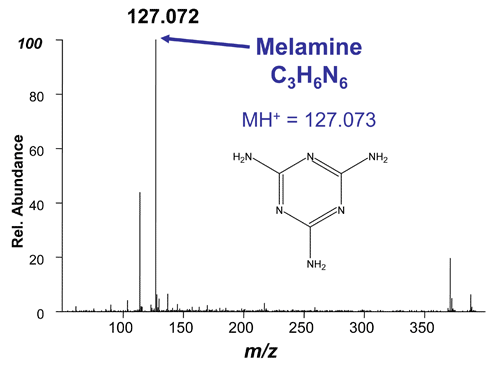(Peabody, Mass.) JEOL USA is pleased to announce that the University of the Pacific has released information on the discovery of a breakthrough testing method for identifying foreign substances in pet food. Using the JEOL DART™ Direct Analysis in Real Time mass analysis technique on the AccuTOF-DART™ mass spectrometer, a chemistry professor and graduate student analyzed some of the recalled pet food.
“The timeliness of this discovery cannot be overstressed,” said Dr. Robert (Chip) Cody, JEOL USA mass spectrometry product manager. “When we learned that Professor Sparkman and Teresa Vail had found a method of identifying the presence of contaminants, such as melamine, after the death of quite a few pets, we felt compelled to share this information.
 (Stockton, Calif.) – A professor and graduate student in University of the Pacific’s chemistry department have developed a new method for determining how to identify foreign substances in pet food. The breakthrough discovery allows scientists to determine whether pet food has been contaminated in a matter of minutes.
(Stockton, Calif.) – A professor and graduate student in University of the Pacific’s chemistry department have developed a new method for determining how to identify foreign substances in pet food. The breakthrough discovery allows scientists to determine whether pet food has been contaminated in a matter of minutes.
Professor O. David Sparkman and graduate student Teresa Vail used a mass spectrometer with the D.A.R.T. (Direct Analysis in Real Time) interface device to determine that a can of dog food that was recently recalled contained melamine, a chemical used in plastic furniture, cookware, and fertilizers. The chemical is at the heart of the nationwide recall of contaminated pet food that has caused numerous animal deaths.

“The significance of the D.A.R.T. mass spectral technique is that results are available in minutes or seconds,” Sparkman said. “Because of enhancements we have made to the D.A.R.T. technology, our answers are definitely unambiguous.”
Mass spectrometry is used to determine the mass of and to identify molecules in substances. By using mass spectrometry, Sparkman said, they were able to determine that a sample of ALPO dog food that had been listed in the recent recall contained melamine. The sample produced an accurate mass signal that is specific to the chemical.
The D.A.R.T. device, when connected to the mass spectrometer machine, allows food substances to be analyzed without the need for any sample preparation, he said. The process takes only a few minutes.

 The traditional process of determining whether a food substance has been contaminated using conventional gas chromatography/mass spectrometry or liquid chromatography/mass spectrometry techniques can take an hour or more. The new method could save federal regulators time and money when testing food imports, Sparkman said.
The traditional process of determining whether a food substance has been contaminated using conventional gas chromatography/mass spectrometry or liquid chromatography/mass spectrometry techniques can take an hour or more. The new method could save federal regulators time and money when testing food imports, Sparkman said.
The idea to use the method came after Ms. Vail received word that some of the cans of ALPO she recently purchased for her own dogs were recalled due to the possibility that they contained melamine. Under Sparkman’s direction, she tested the dog food and found that only one of a dozen cans tested positive for the chemical. Vail said they were using the same testing method in other research projects in the department.
They will present their breakthrough method at an American Society of Mass Spectrometry conference in Indianapolis, Ind., in June.
Sparkman is a mass spectrometry consultant to the U.S. Department of Commerce’s National Institute of Standards and Technology (NIST) and manager of the chemistry department’s mass spectrometry facility.
For more information, contact Professor O. David Sparkman at 209.483.5740 or osparkman@pacific.edu.